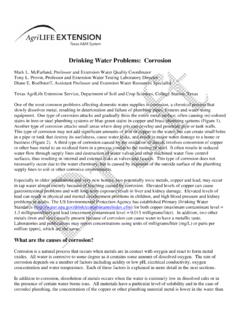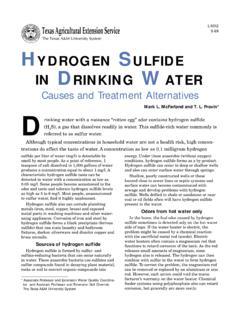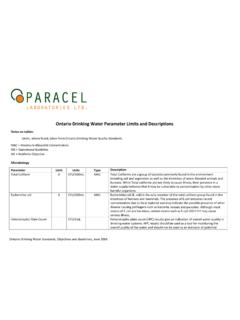Transcription of 2017 Annual Drinking Water Quality Report - Water Utility
1 Page 1 of 6 2018 Annual Drinking Water Quality Report Page 2 of 6 2018 Annual Drinking Water Quality Report For Destin Water Users, Inc. This Report will be available on our website to all of our customers and is also available at the Destin Water Users Administrative Office at 218 Main St., Destin, FL. We are pleased to present to you this year's Annual Water Quality Report . The Water Quality Report is an Annual publication that is required by the Environmental Protection Agency. This Report is designed to inform you about the Quality of the Water and services we deliver to you every day.
2 Our constant goal is to provide you with a safe and dependable supply of Drinking Water . We want you to understand the efforts we make to continually improve the Water treatment process and protect our Water resources. We are committed to ensuring the Quality of your Water . Our Water sources are: ground Water from our 6 coastal wells and Water purchased from South Walton Utility Company, Inc. (SWUCI). All of these wells draw from the Floridan Aquifer. Because of the excellent Quality of our Water , the only treatments required at Destin Water Users and South Walton Utility Company are chlorine and/or sodium hypochlorite for disinfection purposes.
3 Destin Water Users (DWU) routinely monitors for contaminants in your Drinking Water according to Federal and State laws, rules and regulations. Except where indicated otherwise, this Report is based on the results of our monitoring for the period of January 1, 2018 to December 31, 2018. Data obtained before January 1, 2018, and presented in this Report , are from the most recent testing done in accordance with the laws, rules, and regulations. The sources of Drinking Water (both tap Water and bottled Water ) include rivers, lakes, streams, ponds, reservoirs, springs, and wells.
4 As Water travels over the surface of the land or through the ground, it dissolves naturally occurring minerals and, in some cases, radioactive material and can pick up substances resulting from the presence of animals or from human activity. Contaminants that may be present in source Water include: (A) Microbial contaminants, such as viruses and bacteria, which may come from sewage treatment plants, septic systems, agricultural livestock operations, and wildlife. (B) Inorganic contaminants, such as salts and metals, which can be naturally-occurring or result from urban storm Water runoff, industrial or domestic wastewater discharges, oil and gas production, mining, or farming.
5 (C) Pesticides and herbicides, which may come from a variety of sources such as agriculture, urban storm Water runoff, and residential uses. (D) Organic chemical contaminants, including synthetic and volatile organic chemicals, which are by-products of industrial processes and petroleum production, and can also come from gas stations, urban storm Water runoff, and septic systems. (E) Radioactive contaminants, which can be naturally occurring or be the result of oil and gas production and mining activities. In order to ensure that tap Water is safe to drink, the Environmental Protection Agency (EPA) prescribes regulations, which limit the amount of certain contaminants in Water provided by public Water systems.
6 Food and Drug Administration (FDA) regulations establish limits for contaminants in bottled Water , which must provide the same protection for public health. Drinking Water , including bottled Water , may reasonably be expected to contain at least small amounts of some contaminants. The presence of contaminants does not necessarily indicate that the Water poses a health risk. More information about contaminants and potential health effects can be obtained by calling the EPA Safe Drinking Water Hotline at 1-800-426-4791. Page 3 of 6 In the following table, you may find unfamiliar terms and abbreviations.
7 To help you better understand these terms, we ve provided the following definitions in alphabetical order: Action Level (AL): The concentration of a contaminant which, if exceeded, triggers treatment or other requirements that a Water system must follow. Maximum Contaminant Level or MCL: The highest level of a contaminant that is allowed in Drinking Water . MCLs are set as close to the MCLGs as feasible using the best available treatment technology. Maximum Contaminant Level Goal or MCLG: The level of a contaminant in Drinking Water below which there is no known or expected risk to health.
8 MCLGs allow for a margin of safety. Maximum residual disinfectant level or MRDL: The highest level of a disinfectant allowed in Drinking Water . There is convincing evidence that addition of a disinfectant is necessary for control of microbial contaminants. Maximum residual disinfectant level goal or MRDLG: The level of a Drinking Water disinfectant below which there is no known or expected risk to health. MRDLGs do not reflect the benefits of the use of disinfectants to control microbial contaminants. ND : Means not detected and indicates that the substance was not found by laboratory analysis.
9 Parts per billion (ppb) or Micrograms per liter ( g/l): One part by weight of analyte to 1 billion parts by weight of the Water sample. Parts per million (ppm) or Milligrams per liter (mg/l): One part by weight of analyte to 1 million parts by weight of the Water sample. Picocurie per liter (pCi/L): Measure of the radioactivity in Water . 2018 Contaminants Tables Inorganic Contaminants (Note: Data is a compilation of Destin Water Users, Inc. and South Walton Utility Company, Inc.) Contaminant and Unit of Measurement Dates of sampling (mo/yr) MCL Violation (Y/N) Level Detected Range of Results MCLG MCL Likely Source of Contamination Barium (ppm) 01/17-08/17 N 2 2 Discharge of drilling wastes; discharge from metal refineries; erosion of natural deposits Fluoride (ppm) 01/17-08/17 N 4 Erosion of natural deposits; discharge from fertilizer and aluminum factories.
10 Water additive which promotes strong teeth when at the optimum level of Lead (point of entry) (ppb) 01/17-08/17 N 0 15 Residue from man- made pollution such as auto emissions and paint; lead pipe, casing, and solder Nickel (ppb) 01/17-08/17 N N/A 100 Pollution from mining and refining operation. Natural occurrence in soil. Nitrate (ppm) 07/18-08/18 N 10 10 Runoff from fertilizer use; leaching from septic tanks, sewage, erosion of natural deposits Sodium (ppm) 01/17-09/17 N 157* (Avg.) ND-166* N/A 160 Salt Water intrusion, leaching from soil.





